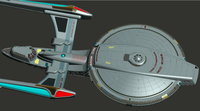Albertus... you're obviously totally oblivious to the actual comment being made.Really, that's about the most realistic idea for describing Star Trek propulsion. Warp drive is just magic, impulse drive ignores Newtonian physics, antigravity has no clear rules. At least a drag chute -type device in space travel would meet the important criteria of not being slave to the rocket equation or the need to carry along the propellant required by Newtonian rules. ........
(What is "wavey"?)
Timo Saloniemi
"most realistic idea for describing Star Trek propulsion.", you have to be joking. Thats wind and sails technology, Larry Niven aside, the area of a 'chute' would have to be enormous and would only slow the vessel, not stop it dead.
Impulse does not ignore newtonian physics, in fact, there are numerous projects, see http://www.j2fi.net/2007/09/11/behold-the-impulse-engine/ as an example.
A 'wavey' is a smiley icon the waves a hand.

And you know what? That's perfectly all right. But what's NOT alright is to be insulting (which is exactly what you're doing here).
Timo and I are both on the same page here... he clearly gets what I've been saying. And you've clearly missed the boat entirely. So before you start getting snide, please take a step backwards and try to first understand the concept you're making fun of. You clearly do not.
You're saying "the area of the 'chute would be enormous." But that only proves that you didn't actually read what was written (while Timo obviously did).
Let me be as clear as possible.
THERE
IS
NO
PHYSICAL
PARACHUTE
INVOLVED
IN
THIS
CONCEPT.
Get it?






